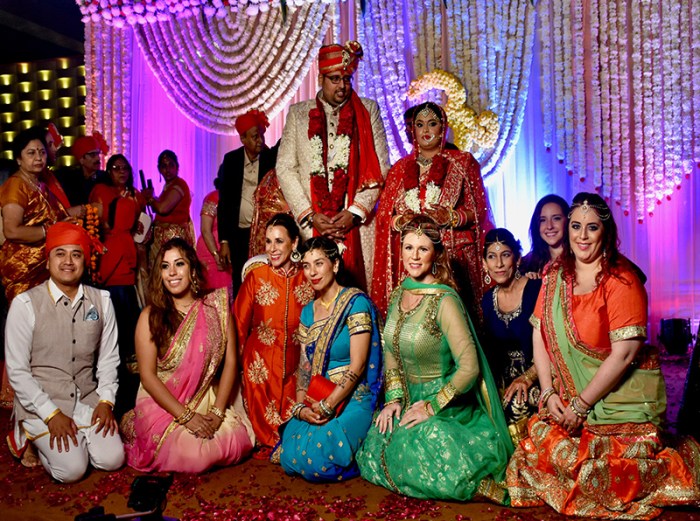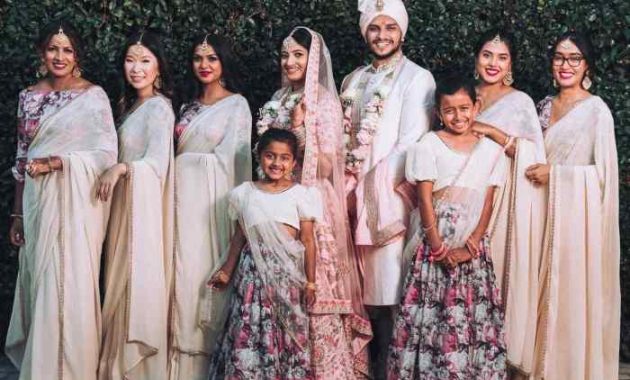Women’s Dresses for Indian Weddings
Women’s dress for indian wedding – Indian weddings are vibrant celebrations of culture and tradition, and the attire plays a significant role in the festivities. Choosing the perfect dress is a crucial part of the experience, reflecting personal style while honoring the rich heritage of Indian fashion. This guide explores the diverse world of women’s Indian wedding attire, covering dress styles, fabrics, color palettes, styling, budget considerations, and ethical choices.
Types of Women’s Dresses for Indian Weddings

Source: aroundtheworldbeauty.com
Indian wedding attire varies greatly depending on the region, the occasion, and personal preference. Several distinct styles exist across the country, each with its unique characteristics and embellishments.
| Dress Type | Region of Origin | Suitable Occasion | Typical Fabrics |
|---|---|---|---|
| Lehenga Choli | North, West, Central India | Ceremony, Reception | Silk, Brocade, Velvet, Net |
| Saree | Across India (regional variations) | Ceremony, Reception | Silk, Banarasi Silk, Kanjeevaram Silk, Cotton |
| Anarkali Suit | North India | Reception, Mehndi | Silk, Georgette, Chiffon |
| Gagra Choli | Rajasthan, Gujarat | Ceremony, Reception | Silk, Brocade, Bandhani |
| Pattu Pavadai | South India (Tamil Nadu) | Ceremony | Silk |
Embellishments vary widely, ranging from intricate embroidery (zardozi, aari, kasuti) and beadwork to the use of sequins, stones, and zari (gold or silver threadwork). The complexity and density of embellishments often reflect the formality of the occasion.
Fabrics and Materials
The choice of fabric significantly impacts the drape, feel, and overall look of the dress. Understanding the properties of different fabrics is essential for making an informed decision.
- Silk: Luxurious, drapes beautifully, available in various weights and textures (Banarasi, Kanjeevaram, Mysore).
- Brocade: Rich, heavy fabric with intricate woven patterns.
- Velvet: Soft, luxurious, ideal for winter weddings.
- Net: Lightweight, sheer, often used for overlays or embellishment.
- Georgette: Flowy, lightweight, suitable for warmer weather.
- Chiffon: Sheer, lightweight, drapes well.
Fabrics suitable for different seasons:
- Summer: Cotton, Chanderi, Organza, Georgette, Chiffon
- Winter: Silk, Velvet, Brocade, Banarasi Silk
Color Palettes and Trends
Color trends in Indian wedding attire evolve, but certain palettes remain timeless. Choosing colors that complement your skin tone is crucial.
| Color Combination | Cultural Significance | Suitable Skin Tone |
|---|---|---|
| Red and Gold | Traditional, auspicious | Most skin tones |
| Maroon and Gold | Rich, regal | Fair to medium skin tones |
| Pastel shades (Peach, Mint, Lavender) | Modern, elegant | Fair to medium skin tones |
| Deep Blue and Gold | Elegant, sophisticated | Most skin tones |
Styling and Accessories
Accessories play a vital role in completing the overall look. Jewelry, footwear, and handbags should complement the dress and occasion.
For example, a heavy lehenga choli might pair well with statement jewelry and embellished footwear, while a simpler Anarkali suit might look best with delicate jewelry and elegant heels. Hairstyles should also be chosen to complement the dress and accessories. A sleek updo might suit a modern saree, while loose curls might complement a traditional lehenga.
Budget Considerations and Price Ranges
The cost of an Indian wedding dress can vary greatly depending on the fabric, embellishments, and designer. Budget-friendly options are available without compromising on elegance.
| Material | Embellishment | Approximate Price Range (USD) |
|---|---|---|
| Cotton | Minimal | $50 – $200 |
| Silk | Moderate | $200 – $1000 |
| Silk | Heavy Embroidery/Zari | $1000+ |
Ethical and Sustainable Choices, Women’s dress for indian wedding
Increasingly, brides are prioritizing ethical and sustainable choices in their wedding attire. This involves considering the environmental impact of production and supporting brands committed to fair labor practices.
Look for brands that use organic or recycled fabrics, minimize water usage, and prioritize fair wages for their workers. Choosing natural dyes over synthetic ones is another way to reduce the environmental impact.
Illustrative Descriptions of Key Dress Styles

Source: getethnic.com
Understanding the visual characteristics of key dress styles helps in making informed choices.
Lehenga Choli: A three-piece ensemble consisting of a long, flared skirt (lehenga), a fitted blouse (choli), and a dupatta (scarf). Lehengas can be made from various fabrics and feature intricate embroidery, beadwork, or other embellishments. The silhouette can range from A-line to mermaid, depending on the style and cut.
Saree: A long piece of unstitched fabric draped around the body in various styles. The draping style can vary regionally and according to personal preference. Sarees are often made from silk, but other fabrics like cotton, chiffon, and georgette are also used. Common accessories include a blouse, petticoat, and jewelry.
Anarkali Suit: A long, flowing tunic (Anarkali) paired with churidar pajamas or leggings. Anarkali suits are typically made from lighter fabrics like silk, georgette, or chiffon and often feature embroidery or other embellishments around the neckline, sleeves, and hemline. The silhouette is characterized by a fitted bodice and a flowing, A-line skirt.
Commonly Asked Questions: Women’s Dress For Indian Wedding
What is the average time it takes to get a custom-made Indian wedding dress?
The time varies greatly depending on the designer and the complexity of the design. Expect anywhere from a few weeks to several months.
How do I care for my Indian wedding dress after the event?
Dry cleaning is generally recommended, especially for delicate fabrics and intricate embellishments. Always follow the care instructions provided by the designer or retailer.
Where can I find affordable yet high-quality Indian wedding attire?
Online marketplaces, local boutiques, and consignment shops often offer budget-friendly options. Consider renting instead of buying if you’re on a tight budget.
Can I wear a certain style of Indian dress to all wedding events?
No, different events (ceremony, reception, etc.) may call for different levels of formality. A lighter, simpler outfit might be appropriate for a daytime event, while a more elaborate one would be suitable for an evening reception.

